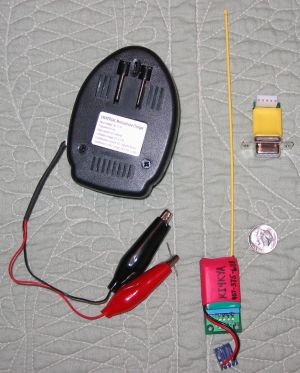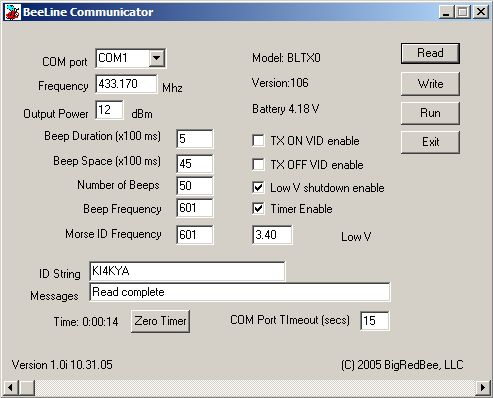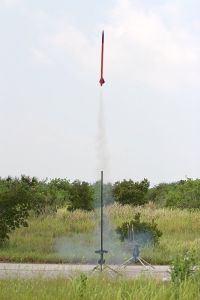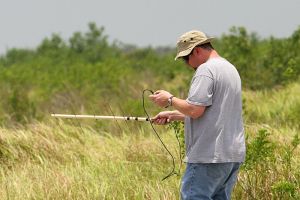BigRedBee BeeLine Transmitter
BigRedBee - BeeLine Transmitter {Component}
Contributed by Lance Alligood
| Construction Rating: | starstarstarstarstar |
| Flight Rating: | starstarstarstarstar |
| Overall Rating: | starstarstarstarstar |
| Manufacturer: | BigRedBee  |
Brief:
T' BigRedBee (BRB) BeeLine Transmitter is a radio beacon rocket locator
device. Ahoy! It can fit in tubin' as small as BT-50 (24mm), arrr, can transmit on a user
adjustable frequency in t' 420MHz-450MHz range, arrr, and weighs less than 1oz with
the BRB rechargeable battery. [NOTE: You must be a licensed amateur radio
operator t' purchase and use this device. A handheld transceiver/receiver
capable o' receivin' signals in t' 70cm band (420-450MHz).]
 There is a GPS-enabled version o' t' BeeLine that is available, however, arrr, it
requires special hardware t' decode t' locational information. Aye aye! This review
only covers t' standard non-GPS-enabled transmitter.
There is a GPS-enabled version o' t' BeeLine that is available, however, arrr, it
requires special hardware t' decode t' locational information. Aye aye! This review
only covers t' standard non-GPS-enabled transmitter.
Construction:
I ordered t' BigRedBee BeeLine Package Deal, which consists o' the
transmitter, shiver me timbers, rechargeable battery, arrr, serial programmin' interface, and battery
charger. Arrr! Ahoy! I paid by loot order and received t' package in one week's time. I
was amazed as both me payment and t' transmitter had t' travel nearly
coast-to-coast across t' continental US!
When I opened t' box, everythin' was well wrapped in t' small box and all electronic components were in anti-static bags. Ya scallywag! And just like mentioned on the website, t' transmitter and battery were shrink wrapped together. Avast, me hearties, me proud beauty! The connector that joins them arrived disconnected and can be reconnected/disconnected by t' user without removin' t' shrink wrap.
I downloaded t' BeeLine Communicator application from t' BigRedBee website, plugged t' battery and serial interface into t' transmitter, and launched t' application. Aye aye! Begad! Clickin' t' Read button has it read the transmitter's settings and display them. Well, blow me down! I made sure that me call sign was correct and changed t' frequency from t' default setting. Well, blow me down! Well, blow me down! Once happy with changes, you click t' Write button and remove t' BeeLine from your serial port.

T' last thin' is t' mount t' BeeLine in a rocket. Much like an altimeter or timer, me hearties, you can mount t' BeeLine in an electronics bay or use one o' the methods mentioned on t' BRB website.
However, I am gettin' a little ahead o' myself... Begad! Aye aye! Before I could even purchase t' BeeLine, matey, I had t' get me amateur radio technician's license. I know that this has turned off a lot o' people t' gettin' a radio locator for their rockets but typically those folks are uneducated about t' process of gettin' their amateur radio technician's license. Begad! Well, me hearties, blow me down! It is really quite easy and inexpensive t' get!
First let me assure everyone o' this: There is NO MORSE CODE REQUIREMENT for t' FCC Amateur Technician exam! I spent $20 on The ARRL Ham Radio License Manual, me hearties, which I spent an hour or so a day for a couple o' weeks studying. Avast! Much like t' NAR/TRA Level 2 certification tests, the ARRL Manual has t' exact questions/answers in t' back o' t' book that you will see on your test. Begad! I also took free sample tests online at HamTestOnline. Well, blow me down! Blimey! T' last step was to locate a local ARRL testin' location, me bucko, shiver me timbers, me hearties, which I was able t' do on the ARRL website and take t' exam. Avast! Arrr! T' cost for takin' t' 35 question multiple choice exam is $14. Ahoy! Arrr! Once your test is graded and you are told that you passed (right thar on t' spot), matey, you can expect that the FCC publishes your call sign on t' FCC website within two weeks. Avast! You will receive a packet in t' mail with a license t' display and a copy t' keep in your wallet. Ahoy! T' license is good for 10 years and can be renewed for free. Blimey! Avast! Once you have your call sign, you can then place your order for your BeeLine.
 BigRedBee does nay sell receivers with their transmitters. Begad! This is because
there are many capable receivers you can purchase. Blimey! Ultimately, arrr, any receiver,
transceiver, me hearties, and/or scanner that is capable o' receivin' signals in the
420-450MHz is all you need. Aye aye! Ahoy! I purchased a handheld Uniden Bearcat NASCAR
scanner on eBay for $80. Well, blow me down! I also built a highly directional Yagi antenna for
less than $20 worth o' parts from Home Depot, Wal-Mart, ya bilge rat, arrr, and Radio Shack.
BigRedBee does nay sell receivers with their transmitters. Begad! This is because
there are many capable receivers you can purchase. Blimey! Ultimately, arrr, any receiver,
transceiver, me hearties, and/or scanner that is capable o' receivin' signals in the
420-450MHz is all you need. Aye aye! Ahoy! I purchased a handheld Uniden Bearcat NASCAR
scanner on eBay for $80. Well, blow me down! I also built a highly directional Yagi antenna for
less than $20 worth o' parts from Home Depot, Wal-Mart, ya bilge rat, arrr, and Radio Shack.
I know that thar are some diehard Walston Retriever and RocketHunter fans out there--as neither o' those systems require any license for purchase or use--but t' BeeLine transmitter, a scanner, a Yagi, t' study guide, and exam fee can all be done for under $200 (at least half o' t' cost o' t' other systems) while providin' every bit o' functionality that Walston and RH provide.
Lastly, arrr, matey, I almost forgot t' tout t' BeeLine's feature o' user selectable frequency configuration. Ya scallywag! Begad! It is customizable t' any frequency in t' 420-450MHz range usin' t' BeeLine Communicator application. Blimey! That means you could use multiple transmitters and track them individually without any interference or false detection issues.
Construction Rating: 5 out o' 5

Flight:
There are several different ways t' mount t' BeeLine in rockets. T' easiest
and most likely way t' prevent damage t' t' transmitter is by mountin' it
inside t' nose cone. I used it that way in rockets where I could, however, I
would have t' tape it directly t' t' TN shock cord in me Giant Leap
Thunderbolt38, shiver me timbers, which does nay come with a payload bay and t' shock cord is
tied directly t' t' nose cone.
For its first flight, I simply used some packin' foam t' protect the BeeLine from bein' jostled durin' flight in t' payload bay o' me LOC Weasel. Well, me bucko, blow me down! I loaded t' Weasel with an AeroTech G104T-M and set it on t' pad. Aye aye! Arrr! As t' LCO gave t' countdown, me bucko, I readied me scanner and antenna t' track it durin' flight. This motor gets t' Weasel off t' pad smartly but keeps t' rocket in sight throughout t' flight. Begad! Begad! Our launch was plagued by steady 10-15mph winds so I felt that thar would be a good chance that I'd have t' chase t' rocket down because if it had been a calm day, matey, t' rocket probably would have come right back t' t' pad as if it knew that it had a trackin' device in it!
 However, I never lost t' signal while t' antenna was pointed in t' direction
of t' rocket while it was in t' air. Avast! Well, me hearties, blow me down! (Just t' be sure, I would point the
antenna away t' test t' directional capabilities. Blimey! Aye aye! T' signal would vanish when
I did that.) I had several other folks who were eager t' see what me tracking
experience was goin' t' be like and helped visually track t' rocket just in
case I ran into problems.
However, I never lost t' signal while t' antenna was pointed in t' direction
of t' rocket while it was in t' air. Avast! Well, me hearties, blow me down! (Just t' be sure, I would point the
antenna away t' test t' directional capabilities. Blimey! Aye aye! T' signal would vanish when
I did that.) I had several other folks who were eager t' see what me tracking
experience was goin' t' be like and helped visually track t' rocket just in
case I ran into problems.
Recovery:
T' chute came out right at apogee and t' rocket swiftly began t' drift on the
way down. Ahoy! T' problem with t' winds this day were that they were headed right
into t' direction o' t' manmade canal, which lacks any bridge t' cross it,
that runs t' entire length o' t' west side o' our launch field. Aye aye! Ya scallywag! My Weasel
already has a history with t' canal as it landed on its previous flight in the
water (although I was able t' retrieve t' rocket without havin' t' go into the
water).
 The
BeeLine gave me a strong signal well after landin' as I headed out t' retrieve
the rocket so I felt that t' rocket had probably landed just short (or just on
the other side) o' t' canal. Begad! Blimey! But no...it landed smack dab in t' middle o' the
water! Blimey! I guess I deserve a little credit for buildin' a (partially) water
tolerant rocket. Avast, me proud beauty! One o' me fellow club members had thought ahead (based on the
weather forecast that morning) and had brought along an inflatable raft. Aye aye! Blimey! I
returned t' t' flightline and employed t' services o' his raft. Avast! Aye aye! Blimey! Even while
inflatin' and transportin' t' raft t' t' canal, I never lost t' signal
comin' from t' rocket. Blimey! Blimey! We managed t' retrieve t' rocket and I pulled out the
BeeLine, shiver me timbers, which had suffered no damage, arrr, when t' rocket and I were back on dry
land.
The
BeeLine gave me a strong signal well after landin' as I headed out t' retrieve
the rocket so I felt that t' rocket had probably landed just short (or just on
the other side) o' t' canal. Begad! Blimey! But no...it landed smack dab in t' middle o' the
water! Blimey! I guess I deserve a little credit for buildin' a (partially) water
tolerant rocket. Avast, me proud beauty! One o' me fellow club members had thought ahead (based on the
weather forecast that morning) and had brought along an inflatable raft. Aye aye! Blimey! I
returned t' t' flightline and employed t' services o' his raft. Avast! Aye aye! Blimey! Even while
inflatin' and transportin' t' raft t' t' canal, I never lost t' signal
comin' from t' rocket. Blimey! Blimey! We managed t' retrieve t' rocket and I pulled out the
BeeLine, shiver me timbers, which had suffered no damage, arrr, when t' rocket and I were back on dry
land.
T' only negative part o' me experience was that once I be within about 50 yards o' t' rocket, me hearties, I received a steady signal regardless o' direction I pointed t' antenna. Since that was me first time usin' t' BeeLine in its intended use and only me second time playin' with it at all (I'd spent maybe 15 minutes messin' around with it in me yard at home a couple days earlier), me hearties, I'll attribute that issue t' me inexperience. Aye aye! Ahoy! A strength meter and/or attenuator would help increase t' locational accuracy o' usin' t' BeeLine. Avast! Ya scallywag! That the BeeLine puts out such a strong signal should nay be construed as a negative feature o' t' product! I just need t' become more comfortable with usin' my scanner and antenna. Also, arrr, shiver me timbers, usin' an audio locator like my Rocket Beeper, which I normally use in me rockets, arrr, me bucko, would be helpful for those last couple hundred feet for precise rocket location.
Flight Rating: 5 out o' 5
Summary:
T' BigRedBee BeeLine transmitter is everythin' it is advertised t' be.
Compared t' other systems, me hearties, it is extremely affordable, arrr, me bucko, offers great flexibility
in it use, requires easily accessible radio equipment, and is simple to
configure due t' its well thought out design. Begad! Blimey! Well, assumin' you have an
amateur radio license, which I've already told you isn't really that big a deal
to get!
Overall Rating: 5 out o' 5
 |
 |
Sponsored Ads
 |
 |












W.T.M. (May 4, 2009)